Getting your snowmobile’s track adjusted correctly doesn’t have to be complicated. In this guide, we’ll show you the tools, step-by-step instructions, and troubleshooting tips for all major brands — Polaris, Ski‑Doo/Lynx, Arctic Cat, Yamaha, and more. If you do it right, your snowmobile will run great quickly. Why Track Tension Matters Track tension directly affects […]
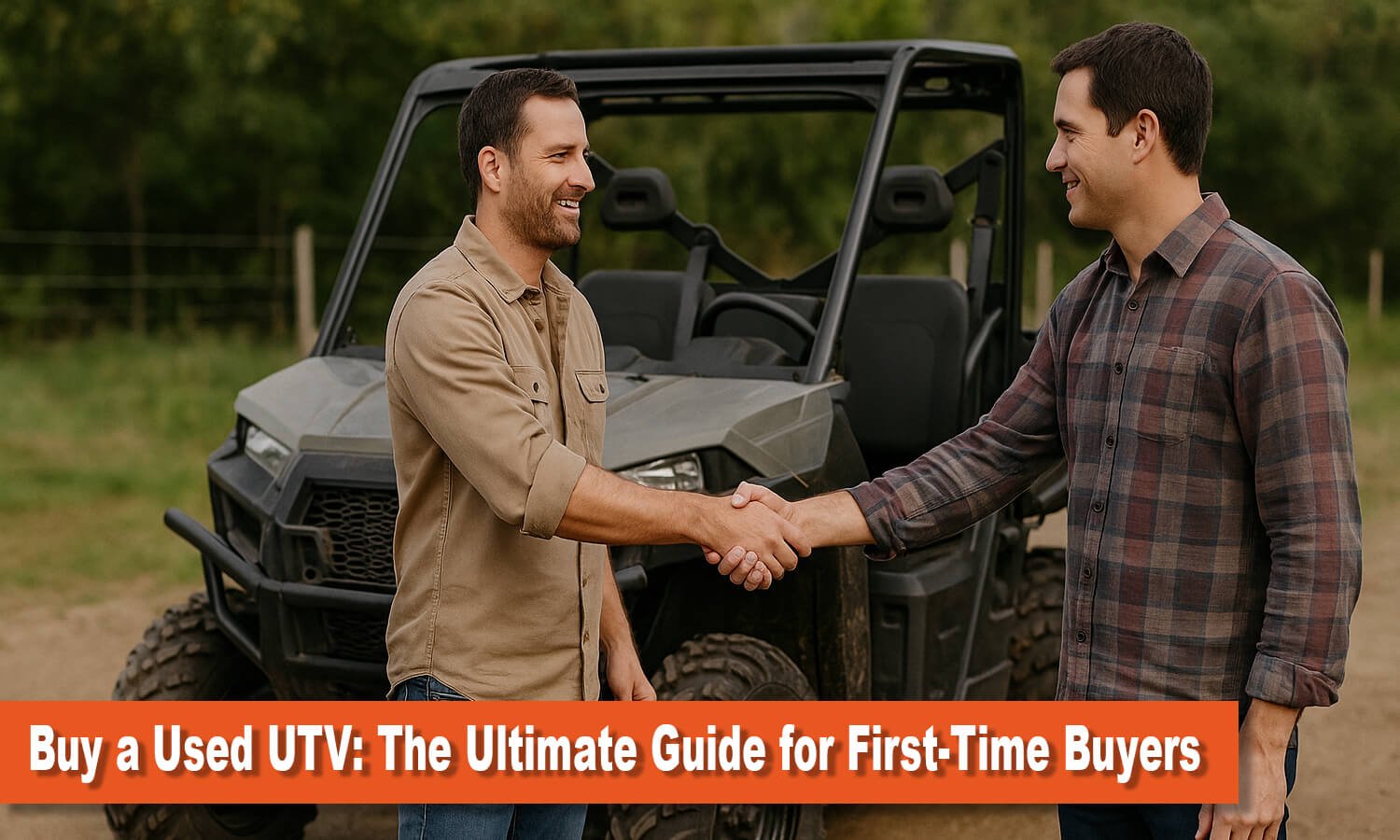
Buy a Used UTV: The Ultimate Guide for First-Time Buyers
Buy a used UTV (Utility Terrain Vehicle) and you’ll save some cash, but it’s important to do your research. UTVs—also called side-by-sides—are larger off-road vehicles with seats for two or more people and are steered with a wheel and pedals. Unlike smaller, single-rider ATVs with handlebars, UTVs are built for both work and recreation, often featuring extra cargo space and higher towing capacity.
In this article, we’ll share some key tips to help you buy a used UTV. Whether you’re looking for a tough workhorse or a fun off-road vehicle, these tips will ensure you make a smart purchase.
Table of Contents
Why Buy a Used UTV Instead of a New One
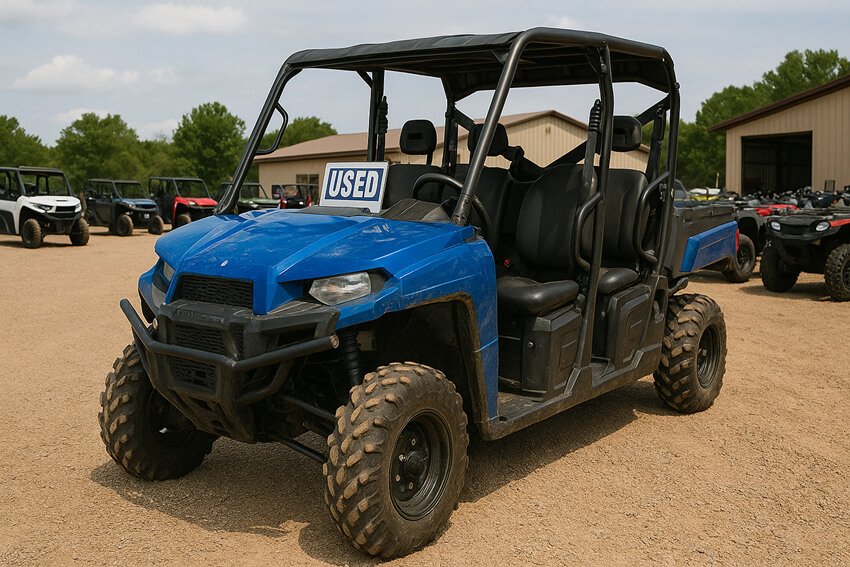
Save big with a used UTV
Used UTVs cost much less than new ones. Thanks to depreciation, a new UTV loses a big chunk of its value as soon as it’s driven off the lot, so the first owner takes the hit. You can often buy a high-quality used UTV at a fraction of the new price. This saves thousands of dollars and means you’ll also pay less for insurance and registration. In fact, one dealer notes that many buyers get hundreds or thousands off the sticker price by going used.
Other advantages of buying used include:
- More choices and faster availability. The used market has many brands, models, years, and options in stock. You can browse local inventory and often find exactly what you want without waiting for a new build.
- Lower insurance and fees. Used vehicles generally cost less to insure. And because you pay less upfront, sales taxes and loan interest (if financing) are lower, stretching your budget further.
- Eco-friendly reuse. Giving a pre-owned UTV another life keeps it out of the scrapyard and reduces waste. It’s an environmentally responsible choice.
In short, a used UTV buying guide often advises: if you don’t need the absolute latest model, a pre-owned machine can give you nearly all the utility at a much lower cost.
Key Factors to Consider Before You Buy
Before you shop, decide what you really need. This will help you narrow choices and avoid regrets.
Budget and Cost of Ownership.
Figure out how much you can spend up front and for ongoing costs. A UTV isn’t just the purchase price – consider fuel, routine maintenance, parts, insurance, and gear. Make sure your budget covers these. Financing or layaway plans may help if you need it.
Intended Use (Sport vs. Utility vs. Recreational).
| Type | Purpose | Features | Best For |
|---|---|---|---|
| Sport UTV | Speed, trail riding | Lightweight, agile, high horsepower | Off-road fun, racing, and trail riding |
| Utility UTV | Work, hauling | Durable frame, cargo bed, towing hitch | Farming, ranching, job sites |
| Recreational UTV | Balanced use | Moderate power, comfort, light hauling | Casual riders, light utility tasks |
Terrain and Trails.
Consider where you’ll ride. Rocky trails, mud bogs, or sand dunes all pose different demands.
Make sure any used UTV you buy is suitable for those conditions (good ground clearance, 4WD if needed, proper tires, etc.).
UTVs used in very harsh terrain wear out faster, so inspect accordingly.
Size and Capacity.
UTVs vary from 2-seat to 6-seat models. How many passengers or how much cargo do you need to carry?
Buying a 4- or 6-seater can be more cost-effective if you ride with family or a crew, rather than owning multiple ATVs.
But larger UTVs take up more space and cost more, so balance capacity with budget and storage space.
Condition and Maintenance History.
A UTV that has been well maintained is worth more than a same-age model that’s been neglected. Ask to see any service logs or maintenance records before buying.
A detailed service book (dates of oil changes, filter swaps, belt changes, etc.) is a strong sign the owner took care of the machine.
If the owner can’t provide records, it makes it harder to know what work was done – be cautious. Also check if any parts (like belts, tires, brakes) are recently replaced or near their end of life.
By considering these factors up front, you can target models that fit your needs and avoid spending on a UTV that’s the wrong size, type, or in poor shape.
Where to Find Used UTVs
| Source | Pros | Cons | Tips |
|---|---|---|---|
| Dealerships | Certified used inventory, warranties | Higher prices | Ask about maintenance history and return policy |
| Online Marketplaces (e.g. Craigslist, Facebook) |
Wide selection, potential bargains | Scams, no guarantees | Meet in safe locations and bring a mechanic if unsure |
| Auctions | Low starting prices, unique finds | Limited inspection, no returns | Attend in person if possible and set a strict budget |
| Private Sellers | Lower cost, room to negotiate | No protection if issues arise | Ask detailed questions and get a bill of sale |
How to Inspect a Used UTV
When you find a promising UTV, do a thorough in-person inspection. UTVs endure hard off-road use, so even slight damage or leaks can indicate bigger problems. Key inspection points include:
Exterior & Frame.
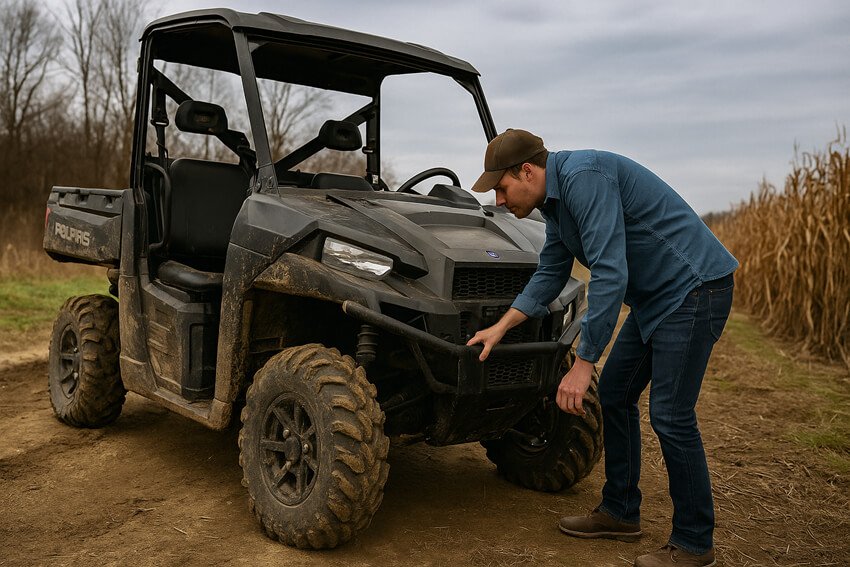
Inspecting a used UTV before purchase
Walk all around the UTV. Look for cracks, dents, or rust on the body panels. Even small scrapes on the plastic can tell you it’s been in heavy field use (which is normal), but any cracks in the frame or roll cage are serious warning signs.
Flip it over if possible or crawl beneath and check that the chassis is straight. Run your hands along welds on the roll bars and frame; feel for signs of recent welding or straightening, which could mean a previous crash or rollover was repaired. Any bends or mismatches in the frame tubes deserve a red flag.
Tires and Suspension.
- Check all tires for remaining tread, uneven wear, or dry rot. Uneven wear can indicate suspension or alignment issues.
- Inspect the shocks and struts closely – there should be no wet spots or oil leaks on the shocks.
- Test for sagging: press down on each wheel and bounce it; the UTV should smoothly absorb bumps, not bottom out or stay sagged.
- Uneven suspension or a bouncy ride suggests worn suspension parts.
- Look at steering components for play or damage.
Engine and Fluids.
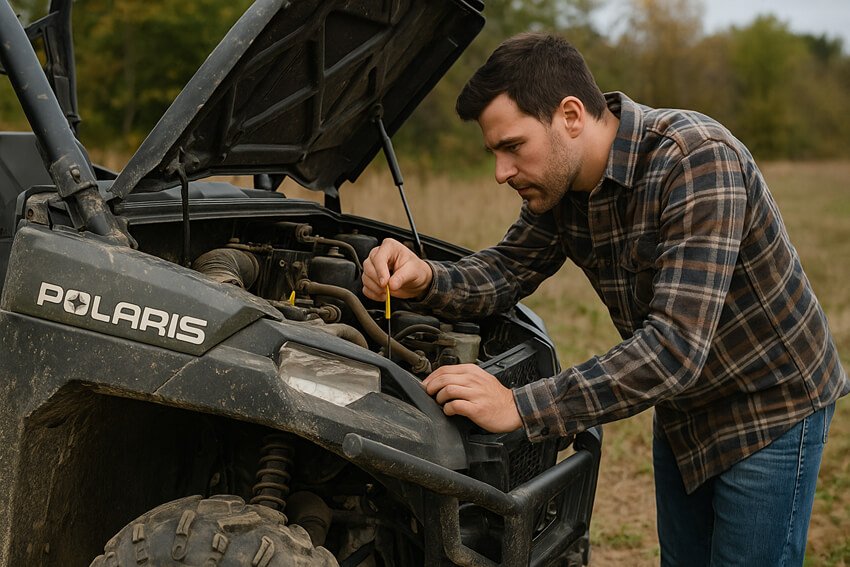
Used UTV engine inspection before purchase
Pop the hood. Look under the engine for fresh oil leaks or drips. Ask the seller not to start the engine before you arrive (a cold engine is easier to inspect).
When you do start it, listen for ticking, knocking, or any unusual noise.
After a few minutes, turn off the engine and check the oil on the dipstick. Oil should be at the proper level and clean (dark but not thick and gritty). If the oil looks milky or has water droplets, that indicates internal leaks or overheating.
The coolant reservoir should be full and the fluid clear; brown or rusty coolant means it hasn’t been changed and may have internal corrosion. Low oil or coolant, or very dirty fluid, is a definite red flag.
Electrical and Controls.
Test all electronics. Turn on the UTV and try the headlights, brake lights, horn, dashboard gauges, and any accessories.
Make sure the gauges (fuel, speedometer, etc.) and lights work. Faulty wiring or burned-out lights are easy fixes, but can be annoying if you overlook them.
Also, inspect the interior: seatbelts should retract and latch, controls (shifters, pedals, throttle) should move smoothly, and no buttons or switches should be broken. Any missing or broken switches might be evidence of aftermarket modifications or abuse.
Being thorough pays off.
Look over everything from the lights to the tires to the electrical systems to catch issues early. If possible, bring along a friend to help, or even hire a mechanic if you’re unsure.
At a minimum, plan to spend 30 minutes to an hour on inspection before making a deal.
Questions to Ask the Seller
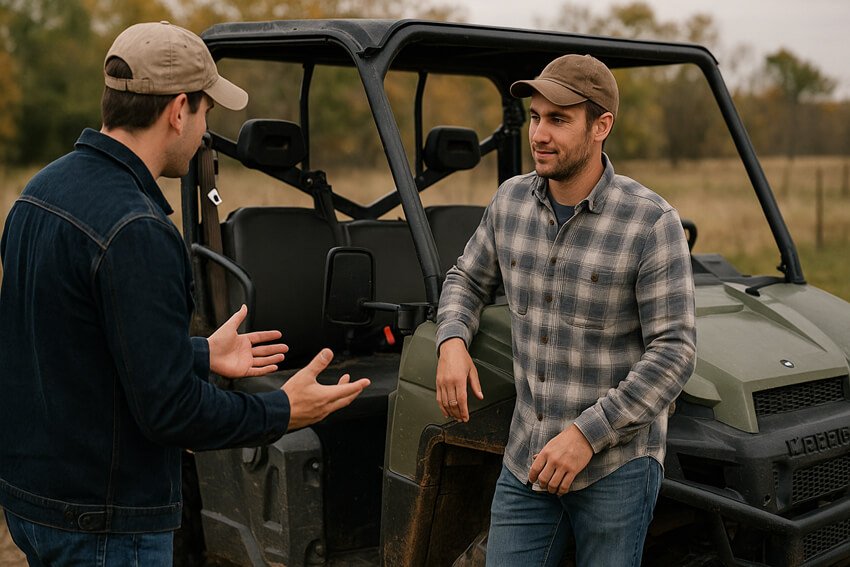
Questions to ask the seller when you buy a used UTV
Good questions can reveal much about the UTV’s history and condition. When you talk with the seller, consider asking:
- Usage and Owner History. “How many owners has it had, and how was it used?” A single owner who used it lightly is usually better than multiple owners or heavy commercial use. Ask if it was used on a farm, for recreation, or any other specific work. Also ask the hours (or miles) on the machine – UTVs count usage by engine hours often, which indicates total run time.
- Maintenance and Repairs. “Do you have maintenance records? What major work has been done?” A well-maintained UTV will have documentation of oil changes, belt replacements, and any repairs. Verify who did the work (dealer or owner). If the seller admits to major fixes (like engine or transmission rebuilds), ask why it was needed. Frequent repairs can signal a problematic UTV, but a proper repair record can also be a reassuring sign.
- Accident or Damage History. “Has it been in any accidents or had any frame damage?” Be wary if the seller hesitates or says “I’m not sure.” If there was a rollover or collision, the roll cage might have been stressed or repaired. Look for supporting evidence (like replaced body panels or new paint patches). Even minor accidents can hide serious issues.
- Reason for Selling. “Why are you selling it?” Sellers will often tell you if the UTV no longer fits their needs. If the reason sounds off (e.g. “I just want a new one” vs. “it keeps breaking down”), that’s a clue. A seller in a hurry to get rid of it may be hiding problems.
- Title and Liens. Ensure the title is clean. “Do you have the original title? Is there any lien or loan on it?” You want a clear title with no outstanding debts. The seller should provide the signed title (or Manufacturer’s Statement of Origin if very new) and a bill of sale. Never pay cash without getting the title paperwork. In most states you are required to transfer the title at the DMV once you buy.
- Modifications and Parts. Ask if any aftermarket parts are on the UTV (lift kits, big tires, engine mods, etc.). Some mods can void warranties or make maintenance harder. Also inquire if any OEM parts have been recently replaced (like a new winch, exhaust, or stereo). Knowing about mods helps you factor in future costs (non-stock parts may be expensive or hard to insure).
By asking the right questions, you’ll learn if the UTV was well cared for or abused. For example, a serious owner should be able to produce service receipts or recall when basic services were done.
If the seller won’t answer or avoids details, consider that a warning sign.
Red Flags and Warning Signs to Avoid
When inspecting and talking, watch for these red flags. Any of these could mean expensive repairs later:
- Frame or Cage Damage. Look under the UTV for frame bends, cracks, or welds. A bent roll cage, uneven frame, or sloppy welding often hides a major crash or rollover. Avoid machines where the structure looks repaired or out of shape.
- Leaking Fluids. Fresh oil, coolant, or fuel leaks under the UTV are trouble. If oil is very low, or if the oil looks brown and murky (with water mixed in), that means the engine was neglected or overheated. Similarly, dirty coolant is a bad sign. Even if it’s a fixable issue, it’s leverage for negotiation – the repair could cost hundreds.
- Smoke or Engine Trouble. A healthy engine should idle smoothly and not produce thick smoke. Watch the exhaust during the test run. Big clouds of smoke (especially blue or white) are dangerous signs. It can indicate oil burning (worn rings) or head gasket failure. If the engine chokes under acceleration or stalls easily, the internals may be worn.
- Excessive Wear. Scrutinize seats, controls, and pedals. If everything is super worn (torn seats, frayed belts) but the hours are low, that’s suspicious. Also, if the tires are extremely mismatched or bald, it suggests the owner hasn’t kept up with maintenance (and you’ll have to replace them soon).
- Missing or Tampered Title. Be very careful if the seller can’t produce a title, or if it looks altered. A missing or mistranscribed VIN on the title is a big no-no. In some states, buying without a proper title makes legal ownership difficult.
Basically, if something feels “off,” trust your instincts. For instance, if the seller is rushing you to buy or the price is too good to be true, it could be a trap.
Smoke, bad smells, or low fluids during a test drive often signal serious hidden issues.
The Importance of Test Driving
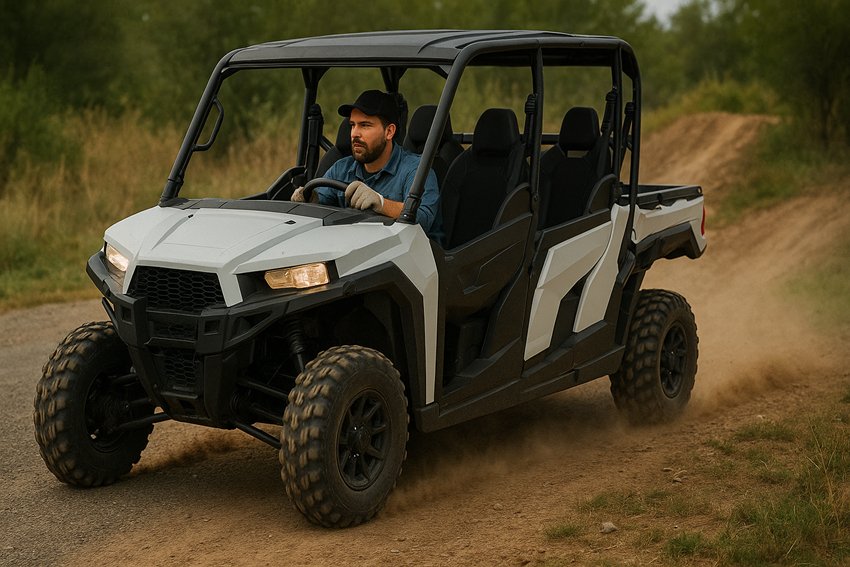
test drive before buying a used UTV
Never buy without driving it. A test drive can reveal issues that a visual inspection won’t. Always start on a flat surface (asphalt or hard-packed dirt) and then move to rough terrain. During the drive, check:
- Brakes. They should stop smoothly without squealing or pulling to one side. Press them firmly – the UTV should stay straight under heavy braking.
- Handling/Steering. Turn the wheel sharply left and right. There should be minimal “play” (dead zone) in the steering. Watch for any grinding or clunking sounds when you turn – that could be bad bearings or tie rods.
- Acceleration/Power. The UTV should accelerate strongly. If it sputters, bogs down, or there’s a lot of exhaust smoke under throttle, that’s trouble. Listen for engine noise or misfires. A healthy engine will pull hard without hesitation.
- Suspension Ride. Go over some bumps or a gravel patch. The ride should feel firm but not bone-jarring. Excessive bouncing or harshness means the shocks or springs are worn. Also, ensure the UTV stays level (no sagging corner).
- Electrical Systems. Turn on every light (headlights, brake lights, turn signals) and accessory (horn, radio, if equipped). Faulty wiring may not stop you from riding, but it could be a nuisance or safety hazard.
A test drive is also your chance to assess general feel and comfort. Are the seats and controls in comfortable positions? Does it feel solid?
If the UTV struggles to start, stalls, or makes disturbing noises, take it as a major warning.
On the other hand, if it performs well in all these areas, that’s a great sign the vehicle is mechanically sound.
Always test on terrain similar to how you’ll actually use it – a UTV that rides okay on road but clunks over simple off-road obstacles may still be problematic.
Negotiating Tips
When you’ve inspected and test-driven, it’s time to negotiate price. Be prepared:
- Do Your Homework. Before talking money, research prices for similar used UTVs in your area. Check multiple listings (dealer and private) to get a fair market range. Knowing average prices gives you leverage.
- Ask for Details. Use any minor issues you found to negotiate. For example, if tires need replacement or a light is out, point that out and request a price cut. Sellers often price themselves in room for negotiation, so don’t accept the first number.
- Get Multiple Quotes. If buying from dealers, contact a few and compare offers. It's recommended to request offers from multiple dealers and use “competitive pricing to your advantage”. Dealers may throw in extras (like accessories or delivery) or small discounts, especially on used inventory.
- Be Polite but Firm. Communicate your budget clearly. It’s okay to make an initial low offer (but not insulting). If the seller won’t budge, be prepared to walk away. Sometimes the hint of losing a sale is enough to get a better deal.
- Timing and Payment. Paying cash or arranging your own financing often gives you more bargaining power than letting the seller’s finance office set up a loan. Also, the end of the month or quarter can be a good time to buy, as dealers may be chasing sales targets.
Paperwork and Title Transfer Basics
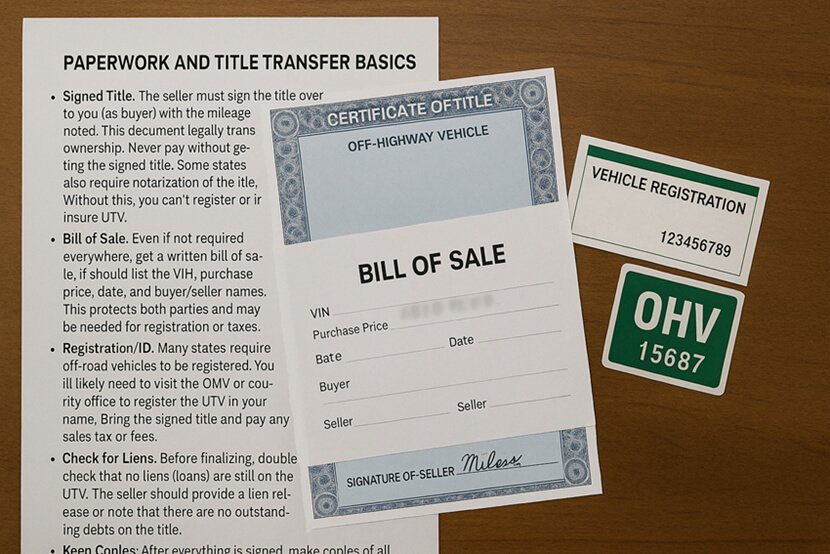
Used UTV paperwork and title transfer
Finally, handle the paperwork correctly. Every U.S. state has its own DMV (or equivalent) rules, but generally:
- Signed Title. The seller must sign the title over to you (as buyer) with the mileage noted. This document legally transfers ownership. Never pay without getting the signed title. Some states also require notarization of the title. Without this, you can’t register or insure the UTV. California’s DMV, for example, explicitly warns that “if you recently bought an OHV (off-highway vehicle), you must transfer the title”.
- Bill of Sale. Even if not required everywhere, get a written bill of sale. It should list the VIN, purchase price, date, and buyer/seller names. This protects both parties and may be needed for registration or taxes.
- Registration/ID. Many states require off-road vehicles to be registered. You’ll likely need to visit the DMV or county office to register the UTV in your name. Bring the signed title and pay any sales tax or fees. For example, California requires payment of a transfer fee, renewal fee, and use tax upon registration. Other states may issue an OHV identification plate or sticker. Make sure you know your state’s rules (and check if a driver’s license or VIN check is needed).
- Check for Liens. Before finalizing, double-check that no liens (loans) are still on the UTV. The seller should provide a lien release or note that there are no outstanding debts on the title.
- Keep Copies. After everything is signed, make copies of all documents (title, bill of sale, any maintenance records, etc.) for your records. Once you’ve transferred the title and registered it, keep the new registration handy whenever you ride.
Conclusion
In summary, buying a used UTV can be smart for first-time buyers if you do your homework. Remember to research models, inspect carefully, ask detailed questions, and take it for a good test drive.
With these pre-owned UTV tips, you’ll be ready to negotiate confidently and handle the paperwork, ending up with a reliable side-by-side that fits your adventures and your budget.

With over 10 years of experience working on cars and trucks Item Training Supervisor Richard Reina is known around the office as one of our technical experts & real an "automobile person".
His rate of interest began, in his very own words, "at the age of two when his father educated him the distinction in between a Chevy and a Ford. Since then it's been cars regularly."
As a serious lover of practically all things with a motor Richard can address nearly any kind of inquiry related to car upkeep, fixing, or restoration & is a fact professional in electric motor background.
Motorcycle riding is all about the sense of freedom, adventure, and thrill of the open road. But come on—being connected when you ride isn't always an easy thing. Whether you're riding with a buddy, navigating traffic in the city, or long-distance riding, effective communication is crucial. That's where the Fodsports T5 and T6 come in, […]
If you're looking for a new motorcycle intercom system this year, Fodsports has something exciting in store. The company has launched two new Bluetooth helmet intercoms: T1 and T1 Pro. Both models bring upgraded features, sleek design, and high-definition audio quality for riders who want to stay connected, entertained, and safe on the road. But […]
Fodsports T1 and T1 Pro: The Newest Bluetooth Intercoms for Riders. Whether you’re cruising on highways, exploring rugged trails, or commuting daily, clear communication is key. Fodsports is thrilled to launch its latest Bluetooth intercoms: the T1 and T1 Pro. Built for riders who demand reliability, versatility, and crystal-clear sound, these devices redefine how you […]
Many riders who aren't so tall or ladies just starting to ride bikes need to pick out the best Motorcycles for Short Riders and Women. They gotta look for three key things: a seat that's not too high up, a bike that's not too heavy, and something that looks good enough to give them confidence. […]
Fodsports FX 60C vs FX30C Pro: What's new techs are the FX 60C bringing to us? Fodsports is a brand worth-mention for helmet communication and video recording. This brand has established itself as a key player with its innovative Bluetooth camera intercom systems. Recently, Fodsports has released a new camera intercom, the FX 60C. How […]
